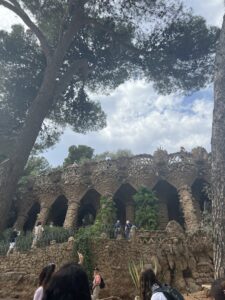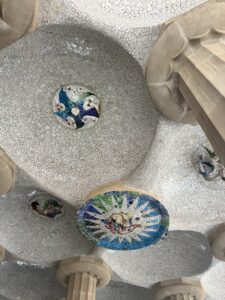By: Baylee Sigman
The same artist who gave us La Sagrada Familia, Antoni Gaudí, also gave Barcelona Park Güell. Gaudí was a very well-known architect at the time from his work and success with La Sagrada Familia, which is in the same neighborhood. Construction began on this park in 1900 and wasn’t completed until 1914. Later established as a public park, it was built in an effort to boost urbanization in the area, and Gaudí’s legacy and popularity would bring this push.
The man who recruited Gaudí, Eusebi Güell, was a wealthy industrialist who already lived on the property with his family. The two worked together closely and had known each other through several past projects before the park. During construction, Güell continued to live in the park, and Gaudí also had a home built to be with his project all the time. Currently, the old home of Güell’s family is a public school, sitting adjacent to the large open square at the peak of the park.
The original plan for the park was to enhance the natural park that sat on the mountain, and then include a multitude of lavish homes and high-quality buildings. With the plan to have a community in this area, Gaudí’s designs are centered around pathways for the families to walk, larger open areas for gatherings, and a specific layout to account for the important buildings, like a community church.
Carmel Hill is home to Park Güell and is known for its fresh air and greenery. The neighborhood was nicknamed La Salut, translated to the health, and the park was meant to keep these natural qualities of the area, and become a healthy, safe place. With these elements in mind, Gaudí committed to a theme of naturalism, and leaned on the art found in nature to create this park.

The park is built in layers, and visitors begin at the bottom, working their way through the rows of greenery until they reach the top, where the space opens up and holds a beautiful view of the city of Barcelona. The network of paths and stairs were made naturally with the earth that was already there, to preserve the topography and keep as much influence of the land as possible.
Gaudí’s respect for the plant life that exists there shows in his designs. He would not interfere with the natural way of vegetation, and where a carob tree grows, he builds around. On our visit to the park, we noticed this for ourselves, where a tree would sprout outwards, hanging over our heads and continuing to branch towards the sun, and Gaudí allowed the space. The deep respect and honoring of nature was something the community admired and encouraged.
In the first few levels of the park, visitors are invited to walk through rows of columns built in the image of trees. Standing tall and sprouting out like branches, these columned rows provide shade from the sun, and a beautiful walk with fresh air. The pathways twisted and winded upwards, each level with its own personality. One specific row included flatter columns that appeared to be waves arching over your head and connecting with the side of the mountain. This brilliant connection with the ocean was inspired by the Mediterranean Sea, which can be seen from the peak as well.


The square at the top was breathtaking, and makes you wonder about the strength of the mountain to hold so many people and so many events. Historically, the square was used for events like festivals, and even car shows, by Catalans. The mosaic seating that wraps around the square is picturesque and is something most people associate with this square. Comprised of broken, glued mosaic pieces, the seats are very comfortable, and each little section has a personality and color theme of its own.
You would not be able to tell from looking at it, but the floor of this square actually does a lot of hard work in preserving this beautiful area. The floor of the square captures rainwater and funnels it though the columns underneath that support the structure, and into a reservoir at the base. Because the area experiences so few days of rain, this basin of water is crucial to the survival of the plants and allows water access year-round. Gaudí’s design: functionality and beauty intertwined.
Considered one of the major tourist attractions of Barcelona, Park Güell remains a place of enjoyment, relaxation, and chance to connect with nature on the Carmel Hill. Open to schools, tourists, and neighborhood residents, this park is accessible, and able to be completed in one day. However, it would take many strolls and trips through the park to identify all of Gaudí’s intricate designs and understand the cultural and social impact of Park Güell.